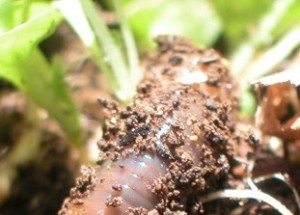Tag: earth worm
Are Earthworms Indigenous to the Americas?
A reader wrote to us a while back with a simple question: is the earthworm indigenous to the Americas? (Technically, he asked where “earth worms” are from, using two words, but six of one, half a dozen of the other.) Fortunately, we have some familiarity with this topic, and it is actually quite fascinating. In a sense, earthworms are indigenous to the Americas – that is, certain species of earthworm are native to the Americas – but these earthworms no longer exist. The earthworms that we now have are not indigenous to the Americas, but instead came from Europe. This is all a little complicated, so below we provide an overview of where earthworms come from, and also detail the impact that earthworms had upon their arrival to the Americas.
What Are the Different Worm Species?
An inchworm is the larvae of moths, of the family Geometridae (phylum Arthropoda, class Insecta, order Lepidoptera). This large, widely diffused group has more than 1,200 species indigenous to North America.
Are Earthworm Bites Poisonous?
Earthworms are gentle creatures. They do not bite, and they do not excrete poisonous juices. In fact, earthworms are just the opposite of poisonous.
How Light and Heat Affect Worms
While light will not kill a worm on contact, the effects of sunlight will. If a worm spends too much time in direct sunlight, usually one hour, it will become paralyzed.
Can Red Worms and Flies Eat a Large Animal?
Red worms are epigeic or detritivorous earthworms. They do not eat animal or human flesh. Red worms are vegetarians, so they eat vegetables and other organic matter. There are more than 120,000 species of flies around the world and many of the most common flies, such as the fruit fly, eat decaying fruits and vegetables as well.
Are Worm Cocoons Dangerous to Eat?
Some worms are actually beneficial to the body, although they are not necessary for survival. Worms are packed with protein, they are a source of nourishment and food for many animals, and they may provide a fair amount of entertainment as documented in the popular book How to Eat Fried Worms.
How Do Earthworms Stay Warm During Winter?
Worms can survive in temperatures ranging from 50-70 degrees Fahrenheit, but the environment must still be moist and dark. When it is cold or dry, worms are not active.
Where Do Worms Go in the Winter?
When the temperature of the soil reaches around 50 degrees Fahrenheit, the worms will make their way back to the upper parts of soil and any eggs will hatch.
What Happens to Earthworms When it Rains?
Earthworm species such as P. corethrurus have low oxygen consumption, meaning, they can survive at lower concentrations of oxygen due to low consumption. This enables P. corethrusus to survive for a very long time when soil is saturated with water.
Weird Black and Green Worms
Although caterpillars and worms have some similarities, many differences exist between the two species. Worms and caterpillars have soft bodies, meaning they do not have a skeletal system, and both animals are nocturnal.
Do Worms Eat Dirt?
Depending on the type of worm, all kinds of plants may be consumed. They eat leaves, dead grass, fruit, vegetables, and all kinds of flowers. These materials contain organisms that provide a steady diet of bacteria, algae, and fungi.
Worlds Largest Worm
This means, the Gippsland rarely leaves its wet underground labyrinth. According to the Museum of Victoria, it is only found in the Bass River Valley of South Gippsland, in an area of about 100,000 hectares bounded by the towns of Loch, Korumburra and Warragul.
How to Get Rid of Worms on Pavement
Bacillus thuringiensis, a wilt pathogen, is available to gardeners to help control infestations. This pathogen is only toxic to insects.
Do Caterpillars and Worms Eat the Same Things?
Worms and caterpillars have strong appetites. Worms eat so much that they typically produce excrement equal to their own weight every 24 hours. Some caterpillars have earned the name “pest” because in high enough numbers they can eat through entire fields of plants and flowers, killing the plants in the process.
Why Do Worms Come Out in the Rain?
Earthworm species such as A. gracilis have high oxygen consumption, meaning, it has greater oxygen consumption, therefore it is more sensitive to depletion of oxygen when the ground is saturated with water.
Types of Caterpillars
Many moth species are better known as caterpillars because of the damage they can inflict to fruit trees and other produce. There are over 180,000 types of caterpillars throughout the world.
What Kind of Animal is a Worm?
Worms belong to the Annelid family. They are an invertebrate, which means that they do not have a spine. This allows them to move freely and with an ease that is not possible for animals that have restricted movement because of their spinal column.
What Do Worms Eat?
Worms feast on dirt as well—especially if they live deeper inside the earth than the norm. Worms also eat plants, fruits, and antioxidant rich vegetables.
Are Caterpillar Parts Like Worm Parts?
In general, worms and caterpillars move slowly, but when either creature senses danger or a predator, they move quickly.
Caterpillar or Worm?
One of the most obvious differences between caterpillars and worms is caterpillars move around on three pairs of legs, while worms have no limbs at all. Worms move around by contracting their segments.




